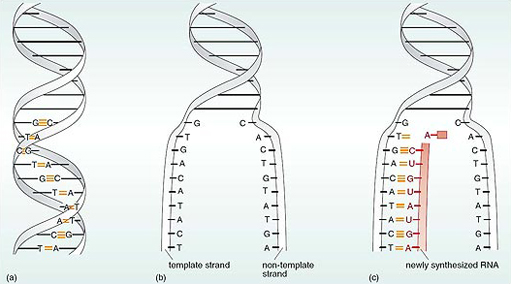4 From DNA to RNA: transcription
In the process of transcription, the information in a gene, i.e. the DNA base sequence, is copied, or transcribed, to form an RNA molecule. RNA is therefore an intermediary in the flow of information from DNA to protein. Before we consider the details of transcription, we will first look at the structure of RNA.
The name ribonucleic acid suggests that RNA is chemically related to DNA. Like DNA, RNA is a chain of nucleotides.
SAQ 2
What are the three component parts of a nucleotide?
Answer
Each nucleotide consists of three parts: phosphate, a sugar and a base.
There are some important differences between DNA and RNA. One way in which RNA and DNA differ is in the sugar component; RNA has ribose (not deoxyribose as in DNA) hence ribonucleic acid. A second difference is in the nucleotide bases.
SAQ 3
What are the four bases in DNA?
Answer
The DNA bases are adenine (A), guanine (G), cytosine (C), and thymine (T).
In contrast, the RNA bases are adenine (A), guanine (G), cytosine (C) and uracil (U). Why one of the four bases in RNA is different from the equivalent base in DNA is not fully understood.
There is a third important structural difference between DNA and RNA. Recall that the basic structure of DNA is a double helix of two spiralled strands, i.e. it is double-stranded. In contrast, RNA is usually a single strand, as shown diagrammatically in Figure 2.
The similarities in structure between DNA and RNA suggest that RNA is synthesized in a manner similar to DNA replication, i.e. using the DNA as a template. This is indeed what happens. The process of transcription is illustrated diagrammatically in Figure 3 (see also the link to the video clip below). As in DNA replication, the starting point is a double helix molecule of DNA (Figure 3a). The length of DNA sequence corresponding to a gene unwinds and the two strands separate (Figure 3b). Here the process of transcription diverges from the familiar one of DNA replication, because synthesis of RNA molecules occurs on only one of the two strands: only one DNA strand is the template for RNA synthesis, and this is termed the template strand. The other DNA strand, which is not used as a template in RNA synthesis, is termed the non-template strand (Figure 3b). The basic mechanism of RNA synthesis is the same as that for DNA, in that pairing of complementary bases is the key to the process. The enzyme that brings about the synthesis of RNA is RNA polymerase, and is a different enzyme from the DNA polymerase that brings about DNA synthesis.
Video: Click to view clip from DNA to RNA: transcription
SAQ 4
Which bases are paired together in DNA?
Answer
C pairs with G, and A pairs with T.

